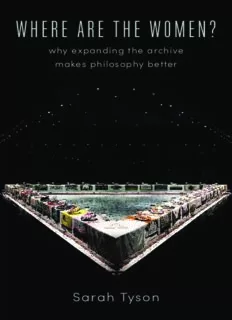
Where Are the Women? Why Expanding the Archive Makes Philosophy Better PDF
Preview Where Are the Women? Why Expanding the Archive Makes Philosophy Better
W H E R E A R E T H E W O M E N ? why expanding the archive makes philosophy better Sarah Tyson WHERE ARE THE WOMEN? WHERE ARE THE WOMEN? WHY EXPANDING THE ARCHIVE MAKES PHILOSOPHY BETTER SARAH TYSON Columbia University Press New York Columbia University Press Publishers Since 1893 New York Chichester, West Sussex cup .columbia . edu Copyright © 2018 Columbia University Press All rights reserved Library of Congress Cataloging- in- Publication Data Names: Tyson, Sarah, author. Title: Where are the women? : why expanding the archive makes philosophy better / Sarah Tyson. Description: New York : Columbia University Press, 2018. | Includes bibliographical references and index. Identifiers: LCCN 2018002866| ISBN 9780231183963 (cloth : alk. paper) | ISBN 9780231183970 (pbk. : alk. paper) | ISBN 9780231545259 (ebook) Subjects: LCSH: Women philosophers. Classification: LCC B105.W6 T97 2018 | DDC 108.2— dc23 LC record available at https: //lccn .loc .gov / 2018002866 Columbia University Press books are printed on permanent and durable acid- free paper. Printed in the United States of America Cover design: Elliott S. Cairns Cover image: Judy Chicago, The Dinner Party, Elizabeth A. Sackler Center for Feminist Art, Brooklyn Museum. © 2018 Judy Chicago / Artists Rights Society (ARS), New York. Photo: © Donald Woodman. For Josh and Iris 1 CONTENTS Acknowledgments ix Introduction xiii 1 Reclamation Strategies 1 2 Conceptual Exclusion 53 3 Reclamation from Absence 79 4 Insults and Their Possibilities 113 5 From Exclusion to Reclamation 141 6 Injuries and Usurpations 173 Conclusion 207 Appendix A: The Declaration of Sentiments and Resolutions 213 Appendix B: Printed Versions of Sojourner Truth’s Speech at the Women’s Rights Convention in 1851 in Akron, Ohio 219 Notes 225 Bibliography 261 Index 271 ACKNOWLEDGMENTS Having done both, I do not know which is harder, writing a book or gestating and giving birth to a baby. They are mostly incomparable, but for me these experiences shared an important feature: they required the support, encour- agement, and critical feedback of many, many people. Books give one the opportunity to thank the people who helped, and thus could begin an extensive list of the differences in these activ- ities. Instead, I would like to thank as many people as I can for making this book possible. First, thanks to all the people who supported my work on this project from its very early stages to right now. It’s hard for me to separate out who gave me support as a friend, a colleague, or a mentor, and I think that is a sign of my great good fortune. My enormous thanks to Buick Audra, Carolyn Benedict, Valri Bromfield, Amy Bryant, Edward Burger, Julie Carr, Polly Case, Amanda Chiampi, Natalie Cisneros, Stacy Clifford, Elizabeth Covington, Kate Cox, Carolyn Cusick, Rebecca Davenport, Christina Dickerson, Idit Dobbs-W einstein, Amanda Dort, Nate Dort, Michael Eck, Sarah Kate Edwards, Teddy Edwards, Pete Emerson, Jennifer Foley, Mona Frederick, Edward Friedman,
Description: